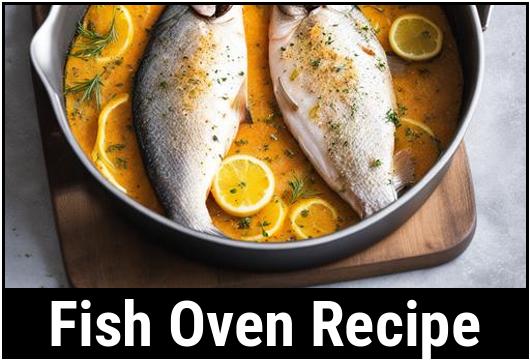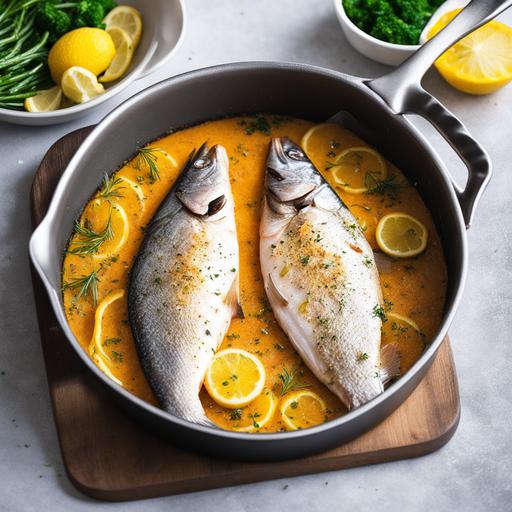
The Ultimate Fish Oven Recipe: Unleashing The Flavors Of The Sea
When it comes to seafood delicacies, few dishes can match the mouthwatering allure of a perfectly cooked fish prepared in the oven. The gentle and controlled heat of the oven allows the fish to retain its natural flavors while enhancing its taste and texture. In this comprehensive guide, we will delve into the intricate world of fish oven recipes, covering everything from the science behind cooking fish to selecting the freshest catch, cleaning and preparation techniques, foolproof tips, delectable variations, and crucial tips on achieving the perfect level of doneness.
The Science Behind Fish Oven Cooking
Understanding the scientific principles that govern cooking fish in the oven is the first step towards achieving culinary excellence. When fish is exposed to heat, several important processes occur within its flesh:
-
Denaturation: As the temperature rises, the proteins in the fish denature, changing their structure and texture. Careful oven cooking ensures the proteins denature gradually, preserving the fish’s tenderness.
-
Gelatinization: The collagen present in fish undergoes gelatinization, which leads to the fish becoming more tender and succulent.
-
Maillard Reaction: This chemical reaction occurs at high temperatures, resulting in the browning or searing of the fish’s surface. It adds depth and complexity to the flavors.
Selecting the Perfect Fish
When embarking on a fish oven recipe adventure, it is crucial to select the right fish. Freshness is paramount, as it directly affects the taste and overall quality of the dish. Some popular fish varieties for oven cooking include:
-
Salmon: Known for its rich, buttery flavor and striking reddish-orange color, salmon is a versatile fish that pairs well with a wide range of flavors.
-
Halibut: With its delicate, flaky texture and mild flavor, halibut is a favorite among seafood enthusiasts.
-
Cod: Featuring a light, meaty white flesh, cod is popular for its versatility and ability to adapt to various seasonings and sauces.
When purchasing fish, observe the following key indicators of freshness:
-
Scent: Fresh fish should have a mild, slightly briny scent reminiscent of the sea. Avoid any fish with a strong, unpleasant odor.
-
Eyes and Gill Color: The eyes of fresh fish should be clear, bright, and not sunken. Additionally, the gills should be pink or red, indicating freshness.
-
Texture: The flesh of fresh fish should be firm to the touch and resilient. Avoid any fish with slimy or dry patches.
Cleaning and Preparation

Once you’ve chosen the perfect fish, it’s time to prepare it for the oven. Follow these steps for optimal cleaning and preparation:
Step 1: Scaling: Using a fish scaler or the back of a knife, remove the scales from the fish. Start from the tail and work your way towards the head. Ensure all scales are removed thoroughly.
Step 2: Gutting and Cleaning: Make a small incision from the belly to the gills and remove the innards of the fish. Rinse the cavity under cold water, ensuring all blood and debris are washed away. Pat dry using paper towels.
Step 3: Trimming and Filleting (optional): If desired, fillet the fish by removing the head, tail, and backbone. This step is optional and dependent on the recipe or personal preference.
Essential Tips for Fish Oven Cooking
To ensure an unforgettable culinary experience, consider the following tips:
-
Preheating: Always preheat your oven to the recommended temperature before placing the fish inside. This ensures even cooking throughout.
-
Oil or Butter: Brush the fish with a high smoke point oil or melted butter to prevent it from sticking to the baking dish and add flavor.
-
Seasoning: Enhance the natural flavors of the fish by using a combination of herbs, spices, and citrus zest. Experiment with flavors like dill, lemon, garlic, and thyme.
-
Moisture Lock: To prevent the fish from drying out, cover the baking dish with aluminum foil or parchment paper during the initial cooking phase. Remove the cover towards the end to allow the fish to brown.
Achieving the Perfect Level of Doneness
Determining when your fish is perfectly cooked requires a keen eye and an understanding of specific visual cues:
-
Temperature: Use a food thermometer to measure the internal temperature of the fish. For most varieties, a reading of 145°F (63°C) indicates doneness.
-
Flaking: Gently insert a fork into the thickest part of the fish and twist lightly. If the flesh flakes easily and appears opaque, it is likely done.
-
Translucency: Observe the fish’s color – it should transition from translucent to opaque, indicating that it is fully cooked.
A Delectable Fish Oven Recipe to Impress

Now that you’re equipped with the essential knowledge and techniques, let’s dive into a delectable recipe that showcases the magic of fish oven cooking:
Oven-Baked Lemon Herb Crusted Salmon
Ingredients:
-
2 salmon fillets
-
2 tablespoons olive oil
-
2 tablespoons lemon juice
-
1 teaspoon lemon zest
-
1 teaspoon dried dill
-
1 teaspoon dried thyme
-
Salt and pepper to taste
Instructions:
-
Preheat your oven to 400°F (200°C). Line a baking dish with parchment paper for easy cleanup.
-
In a small bowl, combine the olive oil, lemon juice, lemon zest, dried dill, dried thyme, salt, and pepper.
-
Place the salmon fillets in the prepared baking dish and brush them generously with the herb mixture, ensuring all sides are coated.
-
Cover the baking dish with aluminum foil and bake for 12-15 minutes, depending on the thickness of the fillets. Uncover and continue baking for 5 minutes to allow the top to brown slightly.
-
Remove from the oven and let the salmon rest for a few minutes before serving. Garnish with fresh herbs and lemon slices for an exquisite presentation.
Overcooking and Undercooking: Finding the Sweet Spot
Fish oven cooking, like any culinary art, requires precision and attention to detail. Overcooking can lead to dry and rubbery fish, while undercooking poses health risks. Here are some guidelines to prevent these pitfalls:
-
Overcooking: Keep a close eye on the fish while it cooks to avoid overdoing it. Remember that fish continues cooking even after it’s removed from the oven, so remove it slightly before it reaches the desired doneness.
-
Undercooking: Undercooked fish can harbor harmful bacteria. Ensure the fish reaches an internal temperature of at least 145°F (63°C) to kill any potential pathogens.
Exploring Exciting Variations
Fish oven recipes offer endless possibilities for creativity and personalization. Here are a few exciting variations to add variety to your seafood repertoire:
-
Asian Glazed Salmon: Brush the salmon fillets with a mixture of soy sauce, ginger, garlic, and honey before baking. Serve alongside steamed rice and vegetables for a delectable Asian-inspired feast.
-
Mediterranean Baked Halibut: Top halibut fillets with a blend of cherry tomatoes, olives, capers, and fresh herbs. Roast until the flavors meld together, creating a stunning Mediterranean delight.
These variations merely scratch the surface of the vast ocean of possibilities waiting to be explored.
Conclusion
By mastering the art of fish oven cooking, you unlock a world of flavors, textures, and aromas that will tantalize your taste buds and impress your guests. Remember to approach each recipe with precision, experimentation, and a touch of passion. With the knowledge gained from this comprehensive guide, you are now ready to embark on your very own fish oven recipe adventure with confidence. Happy cooking and bon appétit!
Sources
FAQS On Fish Oven Recipe
What Type Of Fish Is Best For Oven Cooking?
The best types of fish for oven cooking are thicker fillets or whole fish, such as salmon, trout, cod, or sea bass. These types of fish hold up well to the dry heat of the oven and can be seasoned and cooked to perfection.
How Should I Season The Fish For Oven Cooking?
You can season your fish with a variety of herbs and spices such as garlic, thyme, rosemary, paprika, or lemon pepper. It’s also important to drizzle some olive oil or melted butter over the fish to keep it moist and add flavor.
What Temperature And Cooking Time Is Best For Fish In The Oven?
The recommended temperature for cooking fish in the oven is around 400°F (200°C). The cooking time will vary depending on the thickness of the fish, but a general rule is to cook it for 10 minutes per inch of thickness.
Should I Use A Baking Dish Or A Baking Sheet For Cooking Fish In The Oven?
It is recommended to use a baking dish for cooking fish in the oven, as it helps keep the fish moist and prevents it from sticking to the pan. You can also line the baking dish with parchment paper or aluminum foil for easier clean-up.
What Are Some Side Dishes That Pair Well With Oven-cooked Fish?
There are several side dishes that pair well with oven-cooked fish, such as roasted vegetables, steamed greens, quinoa, rice pilaf, or a fresh salad. These side dishes complement the flavors of the fish and provide a well-rounded and nutritious meal.



